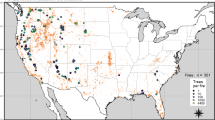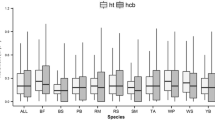Abstract
The condition of tree crowns is an important indicator of tree and forest health. Crown conditions have been evaluated during inventories of the US Forest Service Forest Inventory and Analysis (FIA) program since 1999. In this study, remeasured data from 55,013 trees on 2616 FIA plots in the eastern USA were used to assess the probability of survival among various tree species using the suite of FIA crown condition variables. Logistic regression procedures were employed to develop models for predicting tree survival. Results of the regression analyses indicated that crown dieback was the most important crown condition variable for predicting tree survival for all species combined and for many of the 15 individual species in the study. The logistic models were generally successful in representing recent tree mortality responses to multiyear infestations of beech bark disease and hemlock woolly adelgid. Although our models are only applicable to trees growing in a forest setting, the utility of models that predict impending tree mortality goes beyond forest inventory or traditional forestry growth and yield models and includes any application where managers need to assess tree health or predict tree mortality including urban forest, recreation, wildlife, and pest management.

Similar content being viewed by others
References
Allen, D. C., Barnett, C. J., Millers, I., & Lachance, D. (1992). Temporal change (1988-1990) in sugar maple health, and factors associated with crown condition. Canadian Journal of Forest Research, 22(11), 1776–1784.
Allison, P. D. (1999). Logistic regression using the SAS system: theory and application. Cary: SAS Institute Inc.
Bechtold, W. A. & Patterson, P. L. (eds.) (2005). The enhanced Forest Inventory and Analysis program—national sampling design and estimation procedures. Gen. Tech. Rep. SRS-80. Asheville, NC.
Burns, R. M. & Honkala, B. H. (tech. coords.) (1990). Silvics of North America: 1. Conifers; 2. Hardwoods. Agriculture Handbook 654. Washington, DC.
Castlebury, L. A., Rossman, A. Y., & Hyten, A. S. (2006). Phylogentic relationships of Neonectria/Cylindrocarpon on Fagus in North America. Canadian Journal of Botany, 84, 1417-1433.
Duarte, N., Pardo, L. H., & Robin-Abbott, M. J. (2013). Susceptibility of forests in the northeastern USA to nitrogen and sulfur deposition: critical load exceedance and forest health. Water, Air, & Soil Pollution, 224, 1355.
Eckhardt, L. G., Weber, A. M., Menard, R. G., Jones, J. P., & Hess, N. J. (2007). Insect-fungal complex associated with loblolly pine decline in central Alabama. Forest Science, 53(1), 84–92.
Eckhardt, L. G., Sayer, M. A. S., & Imm, D. (2010). State of pine decline in the southeastern United States. Southern Journal of Applied Forestry, 34, 138–141.
Evans, A. M., & Gregoire, T. G. (2007). A geographically variable model of hemlock woolly adelgid spread. Biological Invasions, 9, 1387–3547.
Fan, Z., Shifley, S. R., Spetich, M. A., Thompson, F. R., III, & Larsen, D. R. (2003). Distribution of cavity trees in midwestern old-growth and second-growth forests. Canadian Journal of Forest Research, 33, 1481–1494.
Fan, Z., Kabrick, J. M., Spetich, M. A., Shifley, S. R., & Jensen, R. G. (2008). Oak mortality associated with crown dieback and oak borer attack in the Ozark Highlands. Forest Ecology and Management, 255(7), 2297–2305.
Fischer, J. E., Bachman, L. M., & Jaeschke, R. (2003). A readers’ guide to the interpretation of diagnostic test properties: clinical example of sepsis. Intensive Care Medicine, 29, 1043–1051.
Greiner, M., Sohr, D., & Göbel, P. (1995). A modified ROC analysis for the selection of cut-off values and the definition of intermediate results of serodiagnostic tests. Journal of Immunological Methods, 185(1), 123–132.
Havill, N. P., & Montgomery, M. E. (2008). The role of arboreta in studying the evolution of host resistance to the hemlock woolly adelgid. Arnoldia, 65(3), 1–9.
Hogg, E. H., Brandt, J. P., & Michaelian, M. (2008). Impacts of a regional drought on the productivity, dieback, and biomass of western Canadian aspen forests. Canadian Journal of Forest Research, 38, 1373–1384.
Houston, D. R. (1994). Major new tree disease epidemics: beech bark disease. Annual Review of Phytopathology, 32, 75–87.
Kenk, G. (1993). Growth in “declining” forests of Baden-Wurttemberg (southwestern Germany). In R. F. Huettl & D. Mueller-Dombois (Eds.), Forest decline in the Atlantic and Pacific region (pp. 202–215). New York: Springer-Verlag.
Klooster, S. H. J., Thomas, E. J. P., & Sterck, F. J. (2007). Explaining interspecific differences in sapling growth and shade tolerance in temperate forests. Journal of Ecology, 95, 1250–1260.
Kobe, R. K., Pacala, S. W., Silander, J. A., Jr., & Canham, C. D. (1995). Juvenile tree survivorship as a component of shade tolerance. Ecological Applications, 5, 517–532.
Korb, T. E., McCormick, L. H., Simons, E. E., & Jeffery, D. J. (1992). Impacts of pear thrips damage on root carbohydrate, sap, and crown characteristics of sugar maples in a Pennsylvania sugarbush. Forest Science, 38, 381–392.
Kulman, H. M. (1971). Effects of insect defoliation on growth and mortality of trees. Annual Review of Entomology, 16, 289–324.
Lawrence, R., Moltzan, B., & Moser, W. K. (2002). Oak decline and the future of Missouri’s forests. Missouri Conservationist, 63(7), 11–18.
Luo, Y., & Chen, H. Y. H. (2011). Competition, species interaction and ageing control tree mortality in boreal forests. Journal of Ecology, 99, 1470–1480.
McClure, M. S., Salom, S. M., & Shields, K. S. (2001). Hemlock wooly adelgid. USDA For. Serv. FHTET-2001-03.14 p.
Mize, C. W., & Lea, R. V. (1979). The effect of beech bark disease on the growth and survival of beech in northern hardwoods. European Journal of Forest Pathology, 9, 243–248.
Morin, R. S. & Liebhold, A.M. (2015). Two invaders collide: a pair of invasive insects intersect and alter the trajectory of eastern forest composition. Forest Ecology and Management.
Morin, R. S., Jr., Liebhold, A. M., & Gottschalk, K. W. (2004). Area-wide analysis of hardwood defoliator effects on tree conditions in the Allegheny Plateau. Northern Journal of Applied Forestry, 21(1), 31–39.
Morin, R. S., Liebhold, A. M., Tobin, P. C., Gottschalk, K. W., & Luzader, E. (2007). Spread of beech bark disease in the eastern United States and its relationship to regional forest composition. Canadian Journal of Forest Research, 37, 726–736.
Morin, R. S., Liebhold, A. M., & Gottschalk, K. W. (2009). Anisotropic spread of hemlock woolly adelgid in the eastern United States. Biological Invasions, 11, 2341–2350.
Nowak, D. J., Kuroda, M., & Crane, D. E. (2004). Tree mortality rates and tree population projections in Baltimore, Maryland, USA. Urban Forestry & Urban Greening, 2, 139–147.
Orwig, D. A., Foster, D. R., & Mausel, D. L. (2002). Landscape patterns of hemlock decline in New England due to the introduced hemlock woolly adelgid. Journal of Biogeography, 29, 1475–1487.
Randolph, K. C., Morin, R. S., & Steinman, J. (2010). Descriptive statistics of tree crown condition in the northeastern United States. Gen. Tech. Rep. SRS–124. Asheville, NC.
Randolph, K., Bechtold, W. A., Morin, R. S., & Zarnoch, S. J. (2012). Evaluating elevated levels of crown dieback among northern white-cedar (Thuja occidentalis L.) trees in Maine and Michigan: a summary of evaluation monitoring. In: Potter, K. M., & Conkling, B. L. (Eds.), Forest health monitoring: 2009 national technical report. Gen. Tech. Rep. SRS-167. Asheville, NC: pp. 219-223.
Riitters, K., & Tkacz, B. (2004). The U.S. forest health monitoring program. In B. Wiersma (Ed.), Environmental monitoring (pp. 669–683). Boca Raton: CRC Press.
SAS Institute Inc. (2009). SAS OnlineDoc® 9.2. Cary: SAS Institute Inc.
Schomaker, M.E., Zarnock, S.J., Bechtold, W.A., Latelle, D.J., Burkman, W.G., & Cox, S.M. (2007). Crown-condition classification: a guide to data collection and analysis. Gen. Tech. Rep. SRS-102. Asheville, NC.
Shigo, A. L. (1972). The beech bark disease today in the northeastern U.S. Journal of Forestry, 54, 286–289.
Steinman, J. R. (2000). Tracking the health of trees over time on Forest Health Monitoring plots. In: Hansen, M., & Burk, T. (Eds.), Integrated tools for natural resources inventories in the 21st century: an international conference on the inventory and monitoring of forested ecosystems. Gen. Tech. Rep. NCRS-212. St. Paul, MN: pp. 334-339.
Swets, J. A., Pickett, R. M., Whitehead, S. F., Getty, D. J., Schnur, J. A., Swets, J. B., et al. (1979). Assessment of diagnostic technologies. Science, 205, 753–759.
Widmann, R. H., Cook, G. W., Barnett, C. J., Butler, B. J., Griffith, D. M., Hatfield, M. A., et al. (2012). West Virginia's forests 2008. Resour. Bull. NRS-61. Newtown Square, PA: 64 p.
Wieferich, D. J., McCullough, D. G., Hayes, D. B., & Schwam, N. (2013). Distribution of American beech (Fagus grandifolia ) and beech scale (Cryptococcus fagisuga Lind.) in Michigan. 2005-2009. Northern Journal of Applied Forestry, 28, 173–179.
Will-Wolf, S., & Jovan, S. (2009). Lichens, ozone, and forest health—exploring cross-indicator analyses with FIA data. In: McWilliams, W., Moisen, G., Czaplewski, R., (Comps.), Forest Inventory and Analysis (FIA) symposium 2008. Proc. RMRS-P-56CD:18 p.
Woudenberg, S. W., Conkling, B. L., O’Connell, B. M., LaPoint, E. B., Turner, J. A., & Waddell, K. L. (2010). The Forest Inventory and Analysis Database: database description and users manual version 4.0 for Phase 2. Gen. Tech. Rep. RMRSGTR-245. Fort Collins, CO.
Yarnold, P. R., Hart, L. A., & Soltysik, R. C. (1994). Optimizing the classification performance of logistic regression and Fisher’s discriminant analyses. Education and Psychological Measurement, 54(1), 73–85.
Zarnoch, S. J., Bechtold, W. A., & Stolte, K. W. (2004). Using crown condition variables as indicators of forest health. Canadian Journal of Forest Research, 34, 1057–1070.
Acknowledgments
We would like to thank Christopher Oswalt, Stan Zarnoch, and two anonymous reviewers for their constructive reviews of earlier versions of this manuscript.
Author information
Authors and Affiliations
Corresponding author
Rights and permissions
About this article
Cite this article
Morin, R.S., Randolph, K.C. & Steinman, J. Mortality rates associated with crown health for eastern forest tree species. Environ Monit Assess 187, 87 (2015). https://doi.org/10.1007/s10661-015-4332-x
Received:
Accepted:
Published:
DOI: https://doi.org/10.1007/s10661-015-4332-x




